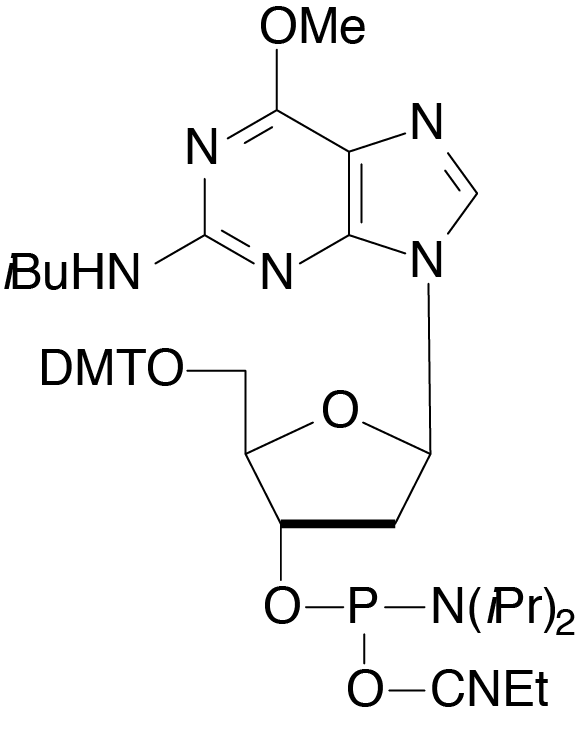| O6-Me-dG-CE Phosphoramidite |

Catalog Number: 10-1070-xx
Description: O6-Me-dG-CE Phosphoramidite
5'-Dimethoxytrityl-N-isobutyryl-O6-methyl-2'-deoxyGuanosine,
3'-[(2-cyanoethyl)-(N,N-diisopropyl)]-phosphoramidite |
| Formula: C45H56N7O8P |
M.W.: 853.97 |
F.W.: 343.24 |
Diluent: Anhydrous Acetonitrile |
| Coupling: No changes needed from standard method recommended by synthesizer manufacturer. |
Deprotection: Treat the CPG with 10% DBU in anhydrous methanol at Room Temperature for 5 days in the dark to cleave and deprotect the oligo.
1) Prepare a solution of 10% DBU in anhydrous methanol. DBU (1,8-Diazabicyclo[5.4.0]undec-7-ene) is available from Aldrich (139009-25G) as is anhydrous methanol (322415-100ML).2) Transfer the CPG to a clean, dry glass vial and add 1 mL of the 10% DBU solution.3) Seal the vial and leave for 5 days in the dark at room temperature.4) Transfer the contents to a micro centrifuge tube and reduce under vacuum to a small volume.5) Add 1mL of 10mM aqueous sodium hydroxide solution and desalt or purify the oligonucleotide using standard procedures. Technical Bulletin |
| Storage: Refrigerated storage, maximum of 2-8°C, dry |
| Stability in Solution: 2-3 days |
MUTAGENESIS
Cellular polynucleotides are alkylated by endogenous components, such as S-adenosylmethionine, or after reacting with two general classes of environmental and laboratory chemicals. SN1 chemical agents include alkylnitrosourea and N-alkyl-N-nitro-N-nitrosoguanidine that react with the N7 position of guanine, N3 of adenine, O6 of guanine, O2 or O4 of pyrimidines, and the non-phosphodiester oxygen atoms of the phosphate backbone. In contrast, SN2 chemical agents such as methyl methanesulfonate and dimethyl sulfate react primarily with the N1 position of adenine (1-Methyl-2’-deoxyadenosine) and N3 of cytosine. To avoid chain branching during synthesis when using DCI as activator, N6-Me-dA is offered with acetyl protection.
If you cannot find the answer to your problem then please contact us or telephone +44 (0)1954 210 200